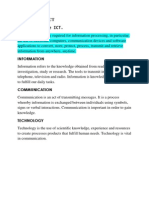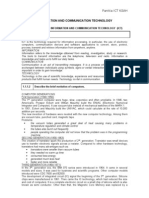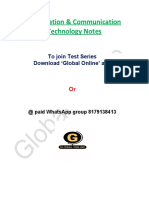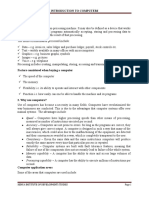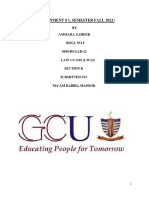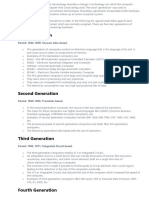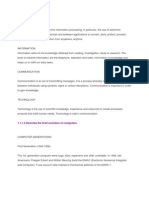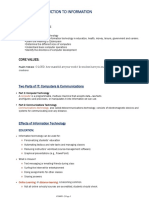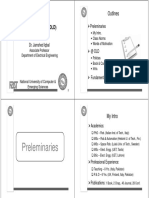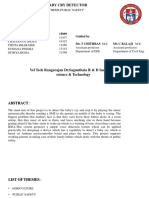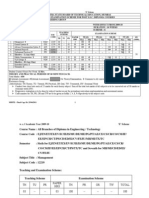0 ratings0% found this document useful (0 votes)
57 viewsPanitia Ict Ksah
Panitia Ict Ksah
Uploaded by
Syahirah IsmailThe document discusses the history and evolution of computers from the 1st to 5th generations. It also describes the usage of information and communication technology (ICT) in everyday life.
The 1st generation computers (1940-1956) were large, slow, expensive, and unreliable. They used vacuum tubes. The 2nd generation (1956-1963) introduced transistors, making computers smaller, faster, and more reliable. The 3rd generation (1964-1971) saw the development of integrated circuits and memory storage. The 4th generation (1971-present) brought personal computers and microprocessors. The 5th generation and beyond focus on more advanced technologies.
ICT is now widely used in education, banking, industry, e
Copyright:
Attribution Non-Commercial (BY-NC)
Available Formats
Download as DOC, PDF, TXT or read online from Scribd
Panitia Ict Ksah
Panitia Ict Ksah
Uploaded by
Syahirah Ismail0 ratings0% found this document useful (0 votes)
57 views8 pagesThe document discusses the history and evolution of computers from the 1st to 5th generations. It also describes the usage of information and communication technology (ICT) in everyday life.
The 1st generation computers (1940-1956) were large, slow, expensive, and unreliable. They used vacuum tubes. The 2nd generation (1956-1963) introduced transistors, making computers smaller, faster, and more reliable. The 3rd generation (1964-1971) saw the development of integrated circuits and memory storage. The 4th generation (1971-present) brought personal computers and microprocessors. The 5th generation and beyond focus on more advanced technologies.
ICT is now widely used in education, banking, industry, e
Copyright
© Attribution Non-Commercial (BY-NC)
Available Formats
DOC, PDF, TXT or read online from Scribd
Share this document
Did you find this document useful?
Is this content inappropriate?
The document discusses the history and evolution of computers from the 1st to 5th generations. It also describes the usage of information and communication technology (ICT) in everyday life.
The 1st generation computers (1940-1956) were large, slow, expensive, and unreliable. They used vacuum tubes. The 2nd generation (1956-1963) introduced transistors, making computers smaller, faster, and more reliable. The 3rd generation (1964-1971) saw the development of integrated circuits and memory storage. The 4th generation (1971-present) brought personal computers and microprocessors. The 5th generation and beyond focus on more advanced technologies.
ICT is now widely used in education, banking, industry, e
Copyright:
Attribution Non-Commercial (BY-NC)
Available Formats
Download as DOC, PDF, TXT or read online from Scribd
Download as doc, pdf, or txt
0 ratings0% found this document useful (0 votes)
57 views8 pagesPanitia Ict Ksah
Panitia Ict Ksah
Uploaded by
Syahirah IsmailThe document discusses the history and evolution of computers from the 1st to 5th generations. It also describes the usage of information and communication technology (ICT) in everyday life.
The 1st generation computers (1940-1956) were large, slow, expensive, and unreliable. They used vacuum tubes. The 2nd generation (1956-1963) introduced transistors, making computers smaller, faster, and more reliable. The 3rd generation (1964-1971) saw the development of integrated circuits and memory storage. The 4th generation (1971-present) brought personal computers and microprocessors. The 5th generation and beyond focus on more advanced technologies.
ICT is now widely used in education, banking, industry, e
Copyright:
Attribution Non-Commercial (BY-NC)
Available Formats
Download as DOC, PDF, TXT or read online from Scribd
Download as doc, pdf, or txt
You are on page 1of 8
Panitia ICT KSAH
INFORMATION AND COMMUNICATION TECHNOLOGY
INTRODUCTION TO INFORMATION AND COMMUNICATION TECHNOLOGY (ICT)
1.1.1.1
Define ICT.
ICT is the technology required for information processing, in particular, the use of electronic computers,
communication devices and software applications to convert, store, protect, process, transmit and retrieve
information from anywhere, anytime.
INFORMATION
Information refers to the knowledge obtained from reading, investigation, study or research. The tools to
transmit information are the telephone, television and radio. Information is knowledge and helps us to fulfill
our daily tasks.
COMMUNICATION
Communication is an act of transmitting messages. It is a process whereby information is exchanged
between individuals using symbols, signs or verbal interactions. Communication is important in order to gain
knowledge.
TECHNOLOGY
Technology is the use of scientific knowledge, experience and resources to create processes
products that fulfill human needs. Technology is vital in communication.
1.1.1.2
Describe the brief evolution of computers.
COMPUTER GENERATIONS
First Generation (1940-1956)
The 1st. generation computer were huge, slow, expensive and often unreliable. In 1946, two Americans,
Presper Eckert and Willian Mauchly build the ENIAC (Electronic Numerical Integrator and Computer). It use
vacuum tube instead of mechanical switches of the MARK 1. In 1951, Eckert and Mauchly build the
UNIVAC, which could calculate at the rate of 10,000 addition per seconds.
The new invention of hardware were needed with the new computer technology. Among them
are vacuum tube, punched card, magnetic tape.
Problems:
•
the vacuum tubes generated a great deal of heat causing many problems in
temperature regulation and climate control
•
the tubes also burnt out frequently
•
people operating the computer did not know that the problem was in the programming
machine
SECOND GENERATION (1956-1963)
The creation of transistor spark the production of 2nd. generation. Transistor was small devices use to
transfer electronic signals across a resister. Compared to other hardware technology, transistors had many
advantages such as:
•
transistors were smaller than vacuum tubes
•
they needed no warm up time
•
consumed less energy
•
generated much less heat
•
faster and more reliable
THIRD GENERATION (1964-1971)
In the 3rd. generation era, the IBM 370 series were introduced in 1964. It came in several models and sizes.
It was used for business and scientific programs. Other computer models introduced were CDC 7600 and
B2500.
The development of integrated circuit (IC) signal the beginning of the 3rd. generation. Silicone chips were
manufactured in 1961. Then came the IC technology, which had reduced the size and cost of computers. It
is a complete electronic circuit on a small chip of silicone which is also known as semi conductor. Other than
that, the Magnetic Core Memory was replaced by a
1
fauzi&ghozes@ksah2009
Panitia ICT KSAH
device called the microchip. Also the first 256 bit RAM was introduced and it was the basis for
development of 1K bit RAM.
Advantages:
A new concept in this generation was that of a family of computer which allowed computer to
be upgraded and expanded as necessary.
•
Silicone chips were reliable, compact and cheaper.
•
Sold hardware & software separately which created the software industry.
•
customer service industry flourished (reservation and credit checks)
FOURTH GENERATION (1971- PRESENT)
The growth of the computer industry developed technologies of computer inventions. There are
many types of computer models such as Apple Macintosh, IBM, DELL & ACER.
In 1971 Intel created the first microprocessor. In 1976, Steve Jobs built the first Apple
computer. Then, in 1981, IBM introduced its first personal computer.
During the 4th. generation, hardware technology such as silicone chips, microprocessor and
storage devices were invented. A microprocessor is a chip which is developed for computer
memory and logic.
The microprocessor is a large-scale integrated circuit which contained thousands of transistors.
The transistors are capable of performing all of the functions of a computer's CPU.
Advantages:
•
Computers became 100 times smaller than ENIAC the first computer
•
Gain in speed, reliability and storage capacity
•
Personal & software industry boomed
FIFTH GENERATION (PRESENT & BEYOND)
The 5th. generation are technologically advance and are still being development to become more efficient.
The inventions of new hardware technology have grown rapidly including many other computer devices such
as silicone chips, processor, robotics, virtual reality intelligent
systems & programs which translate languages
NEW ERA COMPUTER
After the 5th. generation computer, the technology has become more advanced, modern &
sophisticated. The latest invention in are Super Computers, Mainframe Computers, Mini
Computers, Personal Computers & Mobile Computers.
In the new era of computers, expert system such as teleconferencing & speech-recognition
system have been invented as part of communication tools.
1.1.2.1
List the usage of ICT in everyday life.
EDUCATION
In education, teachers, students, researchers and school administrators benefits from the
usage of ICT. Computers offer interactive experiences, enhanced learning, cognitif
development & better management.
Teachers:
~ use computers to search for teaching materials, participate in online forums and online
conferences as well as to aid their teaching.
Students:
~ use the computers as a reference tool. They use computers to browse the internet to look
for information.
Researchers:
~ use computers to collect and process data.
School Administrators:
~ use computers for administrative purposes to make sure that the entire operation runs
smoothly.
BANKING
In the banking, customers, businessman & bank administrator benefits from the usage of ICT.
Customers:
~ can make any transactions at the 24 hour service centres or via online.These services
allow them to do transaction at anytime they want.
Businessman:
2
fauzi&ghozes@ksah2009
Panitia ICT KSAH
~ can save their time by using the online services offered by banks. They can access company accounts for loan
applications, business transactions and update on their cash flow at any time.
Bank Administrator:
~ can oversee the entire banking activities such as reconciliations, inter-branch transactions
(IBT), telegraphic transfer and others by referring to the banking system.
INDUSTRY
Computers are used to facilitate production planning and control systems, to support chain management and
to help in product design in the industrial sector. In the industrial sector, workers, researchers and
administrator benefits from the usage of ICT.
Workers:
~ use machines that are connected to computers to operate. In some productions, robots
are
used to take over jobs that are dangerous to the workers.
Researchers:
~ use computers to analyse and collect research data for future reference.
Administrators:
~ use computers to oversee the entire operations in the plant or factory to detect specific
errors or defects that occurred in the process.
E-COMMERCE
E-commerce helps in boosting the economy. It makes buying and selling activities easier, more efficient and
faster. For this application, computers, Internet and shared software are needed. In the e-commerce sector,
customers, suppliers and employees benefits from the usage of ICT. Customers:
~ use computers to be connected online with suppliers to purchase products. This method
can save time and cost as they do not have to go to any outlets.
Suppliers:
~ use computers to keep track of their transactions. All products are bar coded and can be
read by the computer scanner to help in determining prices and managing inventory.
Employees:
~ use computers and telephones to communicate with their customers for any enquiries.
The
system helps employees to get the latest updates on inventory to be informed to the
customers.
OTHER SECTORS:
Among other sectors that benefit from the usage of ICT are archiecture, arts, career,
goverment, healthcare, home, law enforcement, transportation and travel
1.1.2.2
State the differences between computerised and non-computerised systems.
Before ICT
With ICT
EDUCATION
• depends strictly on teachers &
textbook
• no or limited technology in the
teaching & learning process
• more interesting & interactive
experiences
• enhanced learning
BANKING
SYSTEM
• banking was done manually by
taking deposits directly
• transactions can only be made
during working hours
• takes time to approve any loan
applications
• all transactions are done by
computers
• transaction can be done at
anytime and place
• online services, phone banking
system, credit cards are
available
•
INDUSTRY
• Production was slow because
everything was done manually
and totally depended on human
labour.
• Computers and
telecommunications industry
became very popular and
profitable since production can
be increased through an all day
operation.
3
fauzi&ghozes@ksah2009
You might also like
- NaniDocument15 pagesNaniNani Nanie IINo ratings yet
- Notes Ict MasterDocument49 pagesNotes Ict MasterHZ_93100% (2)
- Information and Communication Technology: Chapter One - Introduction To Ict and SocietyDocument10 pagesInformation and Communication Technology: Chapter One - Introduction To Ict and SocietyDan ChongNo ratings yet
- Short Notes IctDocument7 pagesShort Notes IctNoor Syafiq100% (2)
- Empowerment Technologies: Ms. Erica E. ReyesDocument32 pagesEmpowerment Technologies: Ms. Erica E. ReyesRham Jay SaladoNo ratings yet
- Information TechnologyDocument29 pagesInformation Technologysanchiga nandhiniNo ratings yet
- Unit I DigitalDocument29 pagesUnit I Digitalishmanikour04No ratings yet
- Generation of ComputersDocument36 pagesGeneration of ComputersVasantha KumariNo ratings yet
- ICT English NotesDocument49 pagesICT English NotesAnkita DasNo ratings yet
- Unit I: 1.2 Characteristics of ComputerDocument51 pagesUnit I: 1.2 Characteristics of ComputerVasantha KumariNo ratings yet
- First Generation: Vacuum Tubes. Mid 1940s. IBM Pioneered The Arrang3ment of VacuumDocument12 pagesFirst Generation: Vacuum Tubes. Mid 1940s. IBM Pioneered The Arrang3ment of VacuumwinyeeNo ratings yet
- Ict NotesDocument63 pagesIct Notesmwaurah ndungu100% (2)
- Artisanbeautyhairdressingengineering NotesDocument74 pagesArtisanbeautyhairdressingengineering NoteslavendaveroNo ratings yet
- Computer AssignmentDocument7 pagesComputer AssignmentAmaraNo ratings yet
- Dca-I Notes-1Document13 pagesDca-I Notes-1anshika61410No ratings yet
- Education: 1.1.2.1 List The Usage of ICT in Everyday LifeDocument9 pagesEducation: 1.1.2.1 List The Usage of ICT in Everyday LifeBIawak DophNo ratings yet
- Module 1 Intro To ICTDocument36 pagesModule 1 Intro To ICTZariyah IslaNo ratings yet
- Introduction To ComputersDocument12 pagesIntroduction To ComputersSHUBHAM SINGHNo ratings yet
- Text 2Document5 pagesText 2umamahmirza73No ratings yet
- Module For Chapter 1Document17 pagesModule For Chapter 1cristine de mesaNo ratings yet
- Assignment 1. Living in The IT EraDocument17 pagesAssignment 1. Living in The IT EraTamayo HelbertNo ratings yet
- Mr. Jayesh Gangadhar Shinde: Information and Communication TechnologyDocument141 pagesMr. Jayesh Gangadhar Shinde: Information and Communication Technologyshinde_jayesh2005No ratings yet
- It PDFDocument57 pagesIt PDFgurpreetNo ratings yet
- Information and Communication Technology Full MaterialDocument44 pagesInformation and Communication Technology Full MaterialNizam generalNo ratings yet
- ICT ReviewerDocument5 pagesICT Reviewerchristian b. dellotaNo ratings yet
- Computers NotesDocument41 pagesComputers NotesSHAWN TAKAONANo ratings yet
- IS 151: Introduction To Information and Communication TechnologyDocument44 pagesIS 151: Introduction To Information and Communication Technologydanielvenus023No ratings yet
- Introduction To ICTDocument41 pagesIntroduction To ICTmeekyongcastro99No ratings yet
- 1.1.1.1 Define ICTDocument6 pages1.1.1.1 Define ICTBIawak DophNo ratings yet
- Teknologi Maklumat Dan KomunikasiDocument23 pagesTeknologi Maklumat Dan KomunikasisuhanitaNo ratings yet
- Cit 100Document132 pagesCit 100Visitantuly PilysonNo ratings yet
- Hardaware NotesDocument245 pagesHardaware NotesMayuri ChikordeNo ratings yet
- Introduction and History of Computers 2022-2023 Session-1Document16 pagesIntroduction and History of Computers 2022-2023 Session-1edith Azakaye IzekorNo ratings yet
- I Sem - IT - CompleteDocument130 pagesI Sem - IT - CompletePrameela KNo ratings yet
- Chapter 1: Information and Communication Technology and Society (ICTS)Document9 pagesChapter 1: Information and Communication Technology and Society (ICTS)Ricardo B. ViganNo ratings yet
- Week 1-2 ICTDocument26 pagesWeek 1-2 ICTEM PatindolNo ratings yet
- L1 History of ComputersDocument4 pagesL1 History of ComputersIan CastroNo ratings yet
- 1 Computer Funda-MentalsDocument26 pages1 Computer Funda-Mentalsemmanuelindasi6No ratings yet
- Computer SystemDocument26 pagesComputer SystemMbugua MainaNo ratings yet
- Lecture 1Document33 pagesLecture 1respiciusrwezaula10No ratings yet
- New MAC113-1Document22 pagesNew MAC113-1Jamiu Muibudeen JamtechNo ratings yet
- History of ICTDocument24 pagesHistory of ICTJoannaylish Padillo PerozNo ratings yet
- Yabesh PW of CS XIDocument35 pagesYabesh PW of CS XIYabesh RaiNo ratings yet
- Lesson 1 ICTDocument30 pagesLesson 1 ICTAnonymous AccountNo ratings yet
- Computer Architecture and Organization - 1Document54 pagesComputer Architecture and Organization - 1SENTHIL RNo ratings yet
- ICT Notes For CEE Classes 2017Document62 pagesICT Notes For CEE Classes 2017DmdhineshNo ratings yet
- ICT and Computers in SocietyDocument29 pagesICT and Computers in SocietyAlec Jordan BuencaminoNo ratings yet
- Com111 1Document38 pagesCom111 1Jamiu Muibudeen JamtechNo ratings yet
- Introduction To ICTDocument9 pagesIntroduction To ICTHoodrich PabloNo ratings yet
- Chapter 1 Introduction To Information TechnologyDocument5 pagesChapter 1 Introduction To Information TechnologyJ o h nNo ratings yet
- Chapter 1: Introduction To Information Technology: Learning OutcomesDocument5 pagesChapter 1: Introduction To Information Technology: Learning OutcomesMorpho CloNo ratings yet
- Intro To SE Lecture Notes 1 (Chapters 1-3)Document50 pagesIntro To SE Lecture Notes 1 (Chapters 1-3)ruhamadana.111No ratings yet
- Week 1-2 ICTDocument32 pagesWeek 1-2 ICTAlex HollandNo ratings yet
- Computer Applications - Study Material Unit IDocument12 pagesComputer Applications - Study Material Unit INagendra PrasadNo ratings yet
- CHAPTER 1 - Introduction To Computer BasicDocument9 pagesCHAPTER 1 - Introduction To Computer Basicparishay khan100% (1)
- Introduction To Ict Notes.-1Document150 pagesIntroduction To Ict Notes.-1nyawiraedith44No ratings yet
- It Fundamentals Module (Prelim Midterm) 1Document32 pagesIt Fundamentals Module (Prelim Midterm) 1Jamaica GarciaNo ratings yet
- Unit 1Document15 pagesUnit 1nidaaa.0209No ratings yet
- Preleminaries: Digital Logic Design (DLD)Document7 pagesPreleminaries: Digital Logic Design (DLD)rabiasamadNo ratings yet
- S 11 KeynoteDocument29 pagesS 11 KeynoteDurgadevi BNo ratings yet
- NotesDocument12 pagesNotesPriya SirsatNo ratings yet
- 2018 UG ECE SyllabusDocument236 pages2018 UG ECE SyllabusGuru SundharNo ratings yet
- Radio Sc8562ay Spec enDocument10 pagesRadio Sc8562ay Spec envetchboyNo ratings yet
- Thiết kế mạch điện tử sốDocument22 pagesThiết kế mạch điện tử sốDoanh PhanNo ratings yet
- William Stallings Computer Organization and ArchitectureDocument28 pagesWilliam Stallings Computer Organization and ArchitectureAhmed Hassan MohammedNo ratings yet
- Trends in IC TechnologyDocument26 pagesTrends in IC Technologyhale_209031335No ratings yet
- Log On To IT For CSEC - Roland BirbalDocument1,337 pagesLog On To IT For CSEC - Roland Birbaljaidenholder9No ratings yet
- Development of JTAG Verification IP in U PDFDocument3 pagesDevelopment of JTAG Verification IP in U PDFKesavaram ChallapalliNo ratings yet
- Electronics LifeDocument23 pagesElectronics LifeBlind LuvNo ratings yet
- Construction of Industrial Battery ChargerDocument33 pagesConstruction of Industrial Battery ChargerPETERNo ratings yet
- Seminar ReportDocument25 pagesSeminar Reportpratt2012No ratings yet
- 9 Way Clap Switch!!Document8 pages9 Way Clap Switch!!Trilok Sawant100% (1)
- The 2018 Gan Power Electronics Roadmap: Journal of Physics D: Applied PhysicsDocument49 pagesThe 2018 Gan Power Electronics Roadmap: Journal of Physics D: Applied PhysicsusaravanakumarNo ratings yet
- Nanoelectronics PDFDocument347 pagesNanoelectronics PDFJoyline GermineNo ratings yet
- The Stanford Emerging Technology Review: A Report On Ten Key Technologies and Their Policy ImplicationsDocument157 pagesThe Stanford Emerging Technology Review: A Report On Ten Key Technologies and Their Policy ImplicationsHoover InstitutionNo ratings yet
- MicroChip ManualDocument24 pagesMicroChip Manualms_geoNo ratings yet
- Baby Cry Detector: Theme:Public SafetyDocument14 pagesBaby Cry Detector: Theme:Public SafetyÃbhilâśh RêddÿNo ratings yet
- Scheme - e Sixth Semester (Ej, En, Et, Ex)Document41 pagesScheme - e Sixth Semester (Ej, En, Et, Ex)tilottama_deoreNo ratings yet
- Computer Abstractions and Technology: The Hardware/Software Interface 5Document52 pagesComputer Abstractions and Technology: The Hardware/Software Interface 5Huy NguyenNo ratings yet
- The Generator of Clemente FigueraDocument9 pagesThe Generator of Clemente FigueraDiego Maldinini100% (1)
- Chips 2020Document506 pagesChips 2020Gabriel Donovan100% (4)
- It and Automobile QuizDocument4 pagesIt and Automobile QuizLEX 47100% (9)
- 1.Q. What Is Operating System?Document15 pages1.Q. What Is Operating System?Sourav RoyNo ratings yet
- JBL Pulse 3Document25 pagesJBL Pulse 3marcelomalNo ratings yet
- Diamond Chip Ppt3Document16 pagesDiamond Chip Ppt31bt07ec084No ratings yet
- Computer BasicsDocument409 pagesComputer Basicsmukesh_kumar_470% (1)
- FALLSEM2020-21 ECE2003 ETH VL2020210101783 Reference Material I 14-Jul-2020 DLD SatheeshDocument127 pagesFALLSEM2020-21 ECE2003 ETH VL2020210101783 Reference Material I 14-Jul-2020 DLD Satheeshiugjg1No ratings yet
- Layout Design: 18-322 Fall 2003Document40 pagesLayout Design: 18-322 Fall 2003Sai SadiqNo ratings yet
